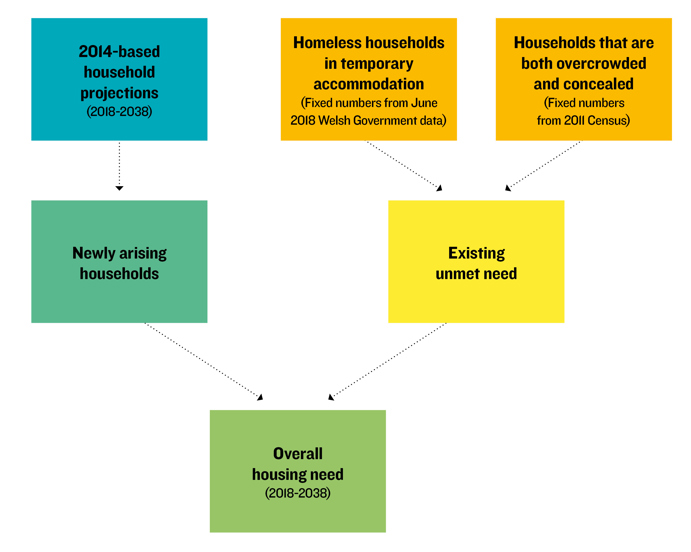On 30 January 2019 the Welsh Government published its 2018-based national and regional estimates of overall housing need in Wales for 2018/19 to 2037/38. These estimates are intended to inform policy decisions, in particular in relation to the emerging National Development Framework (NDF) and future Strategic Development Plans (SDPs). However, Welsh Government has made it clear that the estimates are policy neutral and do not in themselves constitute housing targets.
The national “central estimates” indicate a need for 8,300 additional dwellings per annum (dpa) for the first five years of the 20-year period (2018/19 to 2023/24), decreasing to an average of 3,600dpa during the last five years of the period (2033/34 to 2037/38). This slowing rate of growth mirrors that contained in the 2014-based household projections, which form the basis for the assessment.
Excluding the existing unmet need element, the central estimates indicate a need for 5,417dpa between 2018 and 2038. By comparison, the previous estimates published by the Public Policy Institute for Wales in October 2015 indicated a need for 8,700 new homes per annum from 2011 to 2031.
Does this mean that the need for new housing has significantly reduced? In our view, which seems to be echoed by Welsh Government policy statements, the answer is emphatically no! It is therefore important to understand the basis of these estimates and what they really mean for policy making.
Table 1: National estimates of housing need: newly-forming households (5-year averages)

Source: Welsh Government 2018-based estimates of overall housing need in Wales
Five different scenarios are presented, based on different demographic and migration assumptions, with the national level of need ranging between 6,700 and 9,700dpa during the first five years.
The central estimates for the three identified regions during the first five years (2018/19 to 2022/23) are:
- North Wales: 1,600dpa;
- Mid and South West Wales: 2,000dpa; and,
- South East Wales: 4,700dpa.
Table 2: Regional estimates of housing need (5-year averages)

Source: Welsh Government 2018-based estimates of overall housing need in Wales
The Welsh Government has stated that the estimates will be reviewed “at regular intervals, as and when more up-to-date information becomes available”. However, at the time of writing Welsh Government is unable provide an indication as to when this will be.
Methodology
Following the approach pioneered by the Scottish Government in its Housing Need and Demand Assessment tool, the 2018-based housing need estimates have been calculated based on:
- Newly-arising need, as identified by the 2014-based household projections; and,
- For the first five years of the period only (2018/19 to 2022/23), existing unmet need, comprised of:
a. Homeless households in temporary accommodation (Welsh Government homelessness data (June 2018)); and,
b. Households that were both overcrowded and concealed (Census 2011).
Figure 1: 2018-based housing need estimates: Methodology

Source: Welsh Government Statistical Article (30 January 2019) / Lichfields
Newly-arising need
Whilst the estimates are identified as “2018-based”, they are actually derived from the 2014-based household projections. There are a number of concerns with the use of household projections as the basis for assessing housing need, principally stemming from their derivation from past trends. In the case of the 2014-based projections, the principal projection is based on trends experienced between 2009 and 2014. This data was therefore collected primarily during the recession years, which saw suppressed levels of household formation and reduced housing delivery.
The 2014-based projections indicate a level of household growth that is 21% lower for Wales than the expected level of growth in the previous (2011-based) projections between 2014 and 2036
[1]. The 2014-based projections also indicate a decline of 107,700 working age people (age 16 to 64) (5.6%). The direct translation of these household projections into housing requirements would therefore result in a smaller workforce and potential economic and social difficulties in future.
While it is appropriate that the most recent household projections should form the starting point for housing need assessments in Wales, policy makers should recognise and seek to respond to the specific limitations of the 2014-based publication. In accordance with Planning Policy Wales (ed. 10) plan preparation should also take account of other key factors, including the alignment between housing and jobs, the need for affordable housing, and the objectives of the plan.
In South East Wales, the Cardiff City Deal is seeking a step change to boost the local economy. A continuation of the past trends embodied in the 2014-based projections would be contrary to this strategy and could jeopardise delivery of the City Deal.
It follows that housing requirement policies in the emerging NDF and future SDPs should seek to support the Welsh economy by providing a sufficient number of homes, and of a sufficient quality, to attract and retain skilled professionals and should not carry forward the recession-based trends in the most recent projections.
Existing unmet need
For the first time, the housing estimates take account of “existing unmet need”, i.e. existing households without a home of their own – but only for the first five years of the 20-year period. It is assumed that all of this unmet need, totalling 5,645 households, will be cleared within these five years. The Welsh Government has noted that unmet need figures will be updated when the overall estimates are reviewed.
The Welsh Government has acknowledged that its assessment of existing unmet need is “likely to be an undercount”, as it does not encompass the full range of need for additional homes. In particular, it only includes concealed households where they were both concealed and overcrowded.
Furthermore, single people are not identified as a concealed household under any circumstances, so any single person living in a shared household, for example with parents, or an older person living with an adult child would not be counted. This approach therefore underestimates the number of households in need of a home of their own.
Even more troubling is the fact that the overcrowded and concealed household data is taken from the 2011 Census and is included as a number rather than a proportion of all households. These statistics are now dated. For comparison, we note that the total number of concealed families in Wales increased by 57% (+4,832 households) between the 2001 and 2011 Census
[2].
While the Welsh Government’s inclusion of an element of unmet need in the housing estimates is to be welcomed, it is important to recognise that its approach significantly underestimates the actual level of unmet need.
Tenure breakdown
The overall national and regional housing need estimates will be broken down by tenure in Spring 2019, to include the following sectors:
- Owner-occupier;
- Private sector rent;
- Below market rent; and,
- Social rent.
We will be interested to see how the need for each of these tenures has been calculated and distributed. However, the crucial test will be during plan preparation to understand how these figures are applied in policy – and the extent to which they impact upon viability and deliverability considerations.
[1] The common period covered by both sets of projections
[2] Equivalent data from the 2001 Census on overcrowded and concealed households is not available.







